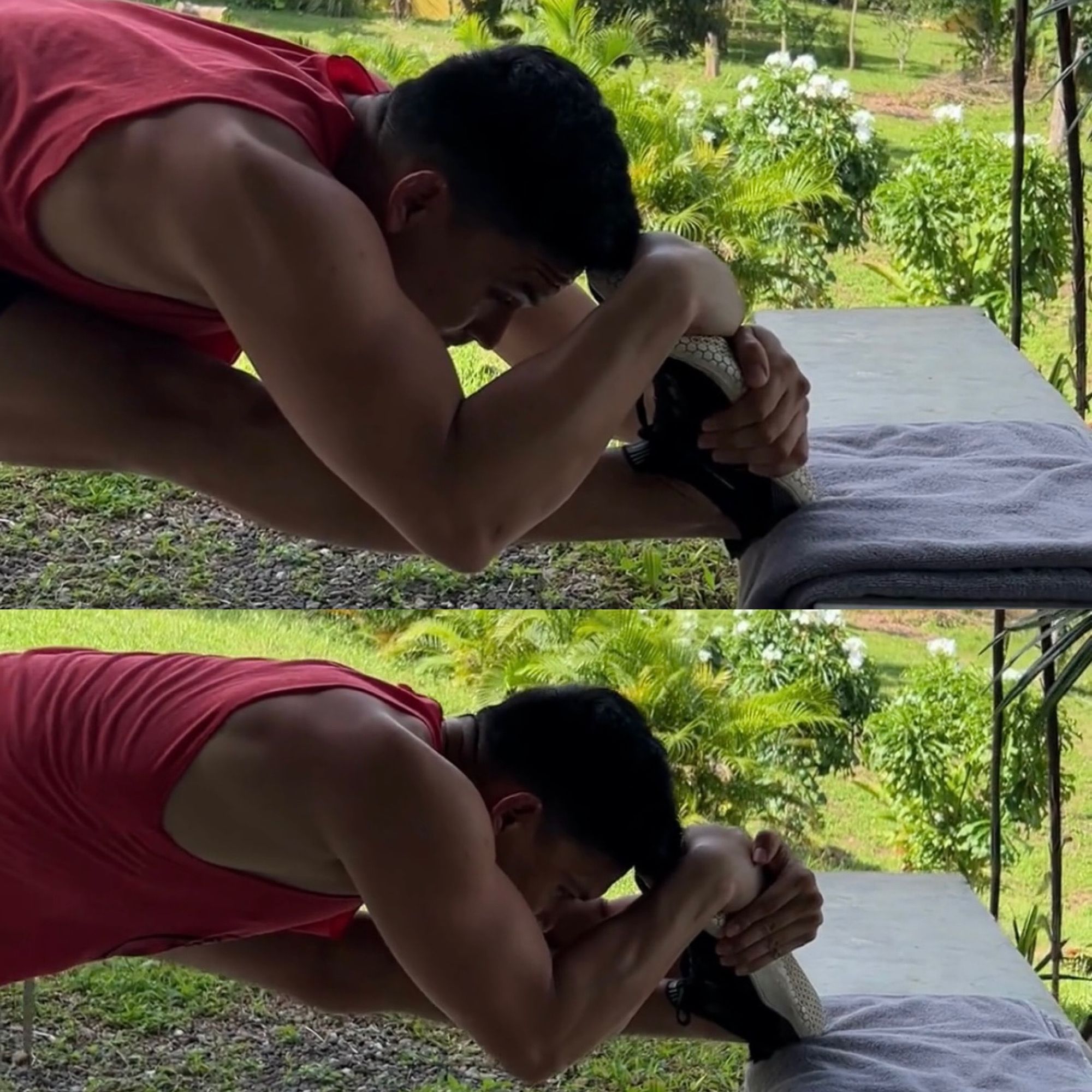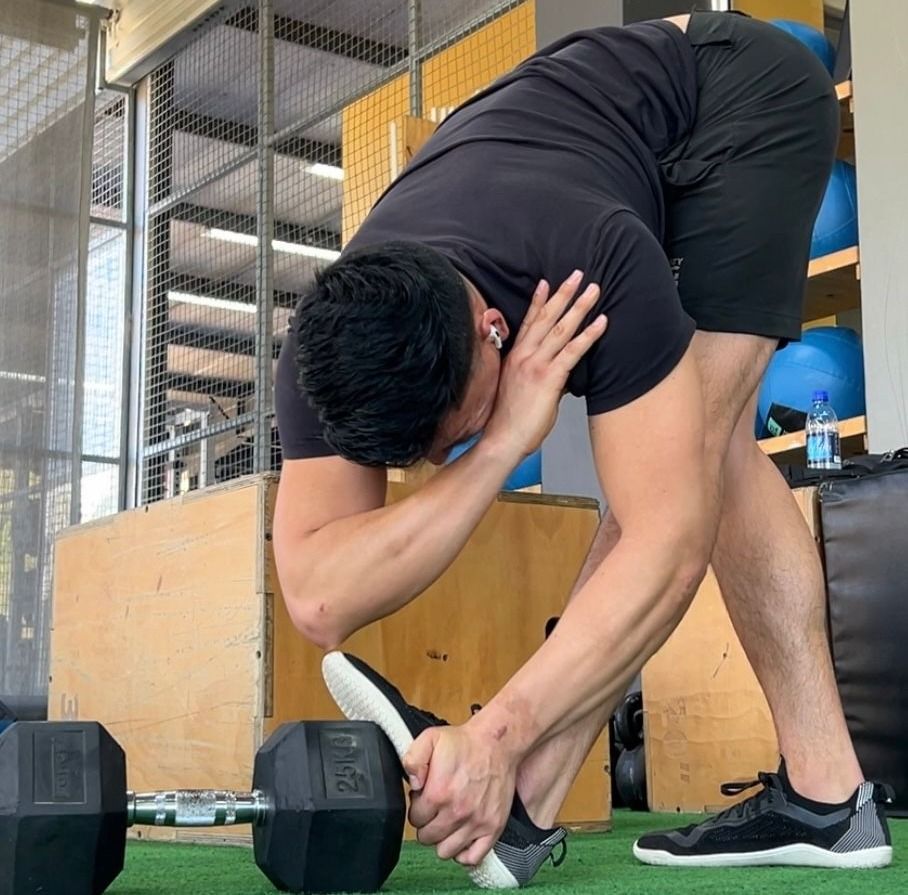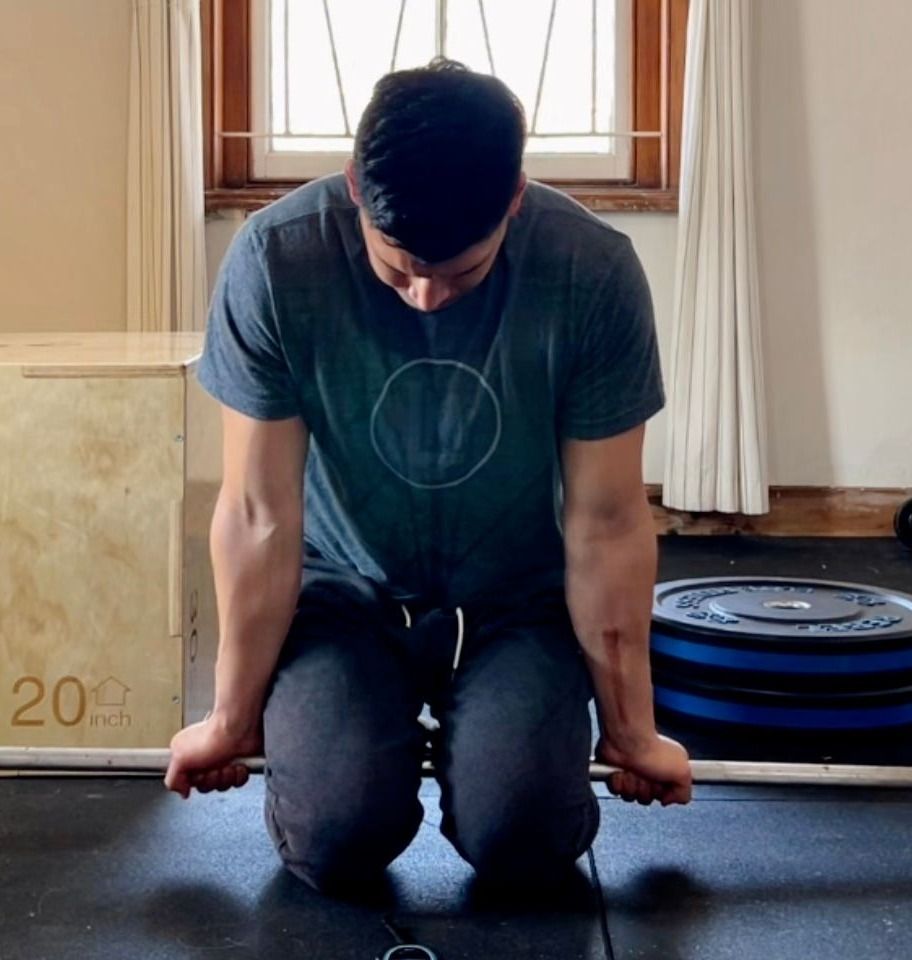H2T Stretching

The purpose of this blog is to share 4 key details that made the H2T process tolerable, sustainable, and set me up for success.
H2T was one of the first big goals that I had when I first started training my flexibility seriously. But I didn't succeed then. I got as far as head to fist on each foot. Which is a seriously amazing milestone in the grand scheme of things. But It wasn't what I visualized.
All I could see was my head on my foot. And that was the problem. I was focused on the end result much more than the process, the nuances, and the experience.
What I want to share in this blog are 4 key details that made the experience manageable, tolerable, sustainable, and set me up for success.

The Protocol
As far as the "program" that I followed, I stuck with Emmet's OG video from 2015. A quick browse through the Reddit bodyweight and Kit Laughlin forums quickly yields countless stories of people's success with this very protocol. So I stuck with it. I did add some of my own flavor to it, which I'll explain below.
- A: 3x90s calf stretch - This part I did approach slightly different. I'll capture my take below.
- B: 3x72 pulses - I was religious about this. No missed sessions until I got the full thing on each foot. Don't cut yourself short here. Get it done.
- I did them BEFORE each of my training sessions. This ensured that I was mentally and physically fresh for the pulses.
- Waiting until after a full on handstand or strength session wouldn't work for me. I go too hard on my sessions, and I'm checked out, ready to eat, work, or chill by the end of them. H2T pulses at that point in time are just too savage.
- Fast mode: 1x36 pulses shortly after waking up.
- It's brutal as fuck. But well worth it. It's a great way to gauge improvements in your cold range of motion as you go through the process.
1) Volume Over Intensity
This is the secret sauce.
High frequency, high volume. Not high intensity.
- Here's my rule of thumb. If you go into the session thinking "this is going to suck" you're already approaching it wrong. It means you're probably going too hard and too deep. Reduce your intensity and your expectations on rate of progress.
- See it as a daily practice. It doesn't matter how deep you got yesterday or the day before. Let the results come as a by product of the frequency and consistency.
- I changed my thought process to be "I'm going to get the reps done, even if that means backing off on the depth". It released me of any preconceived expectations and allowed me to just get the work done.
- You WILL get sore. Emmet says "just push through the doms", and I agree. If you adhere to what I'm saying about focusing on volume over intensity, you'll have no problem pushing through the doms.
- You'll hardly feel the doms by set 2-3 if you approach it this way.
- It took me 5 weeks to get H2T on both legs.
- One side came about a week before the other.
2) Agonist Focus
H2T is not only about the hamstrings and calves. It's a game of hip flexion and dorsiflexion. What I mean is that the hip flexors, quad, and tibia need to work HARD to pull you into the position.
- Keep reminding yourself of this over the set. It's really easy to let go of these short range contractions.
- There were several occasions where my quads were trembling from how hard I was contracting them.
- As well as several occasions where my hip flexors cramped.
- Your tibia should be burning from how hard you're dorsiflexing. Think "toes to shin"
Because the shortening contractions are so critical for success, there were several occasions where I preceded the pulses with a movement that really fires up the quads and hip flexors.
Block crushes and knee extensions will do the job. Feel free to get creative here. A standing block crush, a very compressed and loaded knee extension....
Here's an idea that utilizes both in one go.
3) Opposite Elbow To Toe
Don't underestimate the potency of seriously developing your opposite elbow to toe range of motion and comfort.
What do I mean by "seriously developing"? There's a good chance you'll have the flexibility to work on your head to toe range of motion, before you feel even remotely comfortable in opposite elbow to toe.
I recommend sticking with opposite elbow to toe until you have a very firm contact for at least 2 sets of 72 pulses without feeling like you're going to explode.
The cross body action of the torso targets the lateral (outside) hamstring quite intensely. For many people, freeing up this area can have a massive carry over to other positions that require a high degree of hamstring flexibility, such as front splits.
I recommend keeping your hand in the same place of your opposite shoulder so to keep progress measurable and objective.

4) Shoes, Supports, and False Grip
Pulsing/ ballistic stretching has profound origins in Chinese martial arts. They pulse their way into all sorts of wild positions. I've watched countless videos and carefully observed a handful of practitioners, and one thing that I've noticed is that they almost always do 3 things.
- Use supports - Unless they're doing standing splits, they'll always place their foot against a support. This can be a stack of weight plates, a heavy dumbbell, a ledge, a firm yoga block, or a wall.
- If you're early in your journey, foot on the floor against a ledge is a good starting point
- Wear shoes - Wearing shoes allows you to leverage yourself into the stretch much more comfortably. To maximize your dorsiflexion, it helps to place quite a lot of weight onto the balls of your feet. Without shoes, it's uncomfortable, and the nervous system will detect this and limit your depth.
- Utilize a false grip. Leverage, leverage, leverage. You'll be able to pull into much more dorsiflexion by using a false grip.
- At the moment, the only way that I can get head to toe on each leg is by using a false grip with both hands.
- You'll see the legendary Jade Xu using this technique in the video below.
5) Calf Work
Emmett gives two recommendations in his protocol. One on calf stretching and one on rolling out the calf.
Calf Stretch
- 3 position calf stretch on a ledge, 90s each position. Foot internally rotated, neutral, and externally rotated. This way, each compartment of the calf gets stretched. Brilliant idea and what I recommend everyone start with. It takes time, but the pulses feel night and day different when you do it.
- After a few weeks, I found that I didn't feel much of a stretch in certain positions (ER, neutral, IR). So I just only stretched in the position where I felt a stretching sensation.
- It then progressed to the point where I only needed one set. I would hold the stretch long enough until I no longer felt a stretch sensation.
- I also varied the calf stretch every session. I've shared a handful of different calf stretches here in the newsletter already, so I won't share more. But it allowed me to always find a stretch that really hit the spot.
Calf Smash
Emmet recommends using Kit Laughlin's stick method to roll out the calves a few times per week and mentions how invaluable it is.
I couldn't agree more! It's overwhelmingly invaluable! If you're anything like me and have seriously nervy, sensitive, and tight calves, then you'll also find it an incredibly potent tool.
I also used Kit Laughlin's method, linked below. Except that I started with a stick and progressed to a barbell.
I saw huge improvements in my sensitivity to the pulses once I was able to place a decent amount of weight on my calves with the 20kg barbell. But don't start here. Start with a stick. It can bring tears to the eyes rather quickly.
My approach here was to roll my calves long enough that the intensity went down significantly. About 3-8ish minutes most of the time.
The trick is managing the intensity and relaxing as much as possible.

Example Program
If you're going to fully take on H2T as I explained above, high volume, high frequency. I recommend you reduce much of your other hamstring work and only focus on this. Otherwise, it could quickly result in too much overall volume and result in niggles or injuries.
Here's what the approach may look like once it's all gathered together and reduced to a simple program.

And if you take it for a spin, I'd love to see your progress and results! Feel free to send them to me privately or tag me on IG any time!
Did you enjoy reading this article?
If you did, I encourage you to subscribe to my weekly newsletter, The Sunday Spread, where I share free resources like the content of this blog, training tips and more. You can sign up by hitting the button below!
Los

